The Ultimate Kitchen Design Inspiration Guide for Newfoundland Homeowners
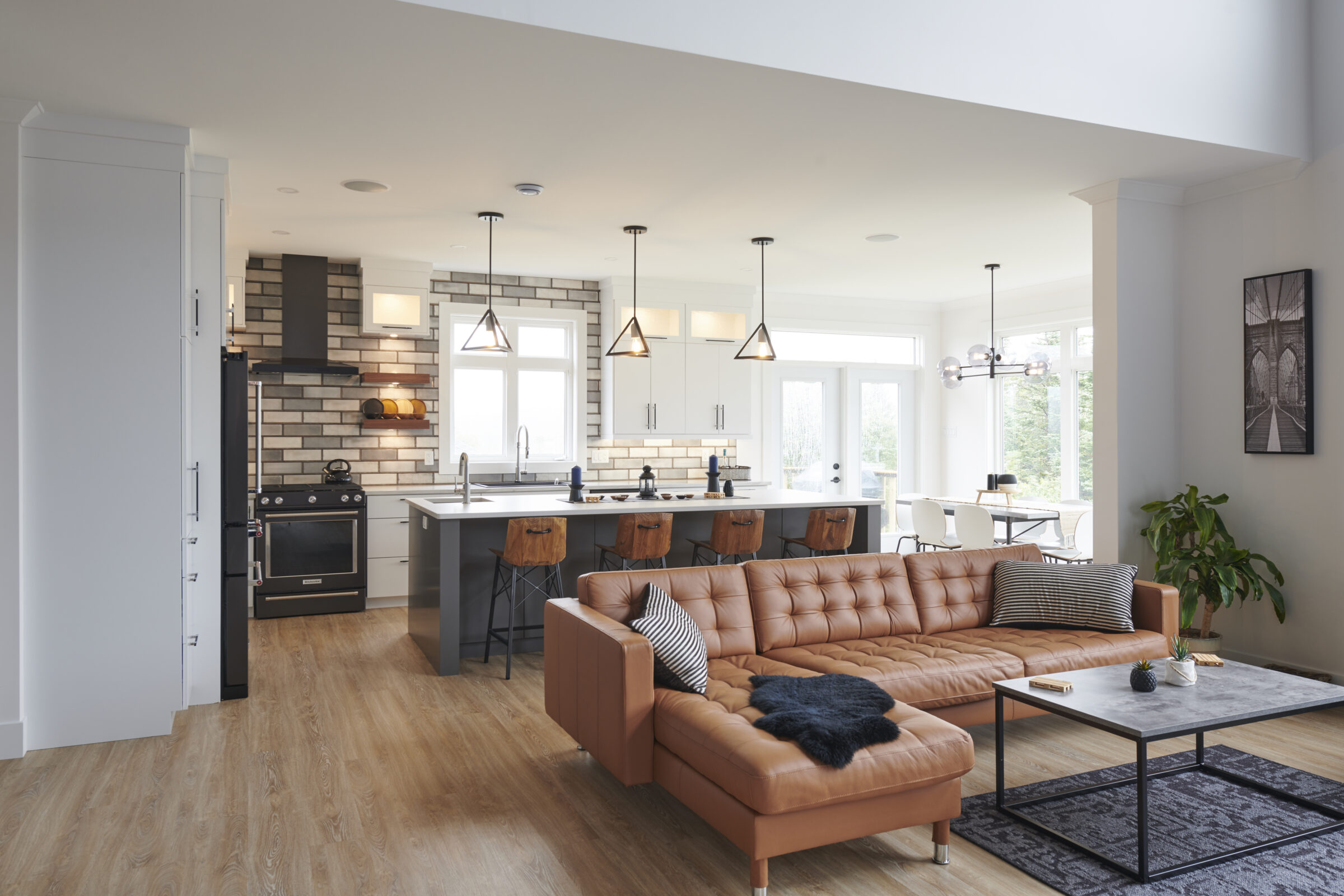
Many homes across Newfoundland are filled with character, but the kitchen often gets left behind. Whether you’re in a classic saltbox or a newer build, it’s frustrating when your kitchen doesn’t reflect your lifestyle or the deep roots of your home. That tension between tradition and function can leave you feeling stuck, torn between preserving charm and embracing convenience. Too often, homeowners settle for designs that feel either dated or disconnected, missing out on the comfort and personality a well-designed kitchen can offer.
If you’re looking for thoughtful kitchen design in Newfoundland, our kitchen inspiration guide is the perfect place to start. Inside, you’ll find practical kitchen design ideas for blending heritage details—like shaker cabinets, beadboard panelling, and apron-front sinks—with modern features such as quartz countertops and concealed appliances. This guide will help you create a kitchen that’s not just beautiful, but also tailored to the way you live, season after season.
Prioritize Materials That Suit the Climate

Newfoundland’s climate brings its own design considerations. Even indoors, your kitchen should be able to handle high humidity, fluctuating temperatures and salty coastal air. Without the right materials, surfaces can warp, peel or degrade over time, especially in high-traffic areas.
Engineered wood is a durable alternative to solid hardwood. It resists moisture and shifting, making it a dependable choice for cabinetry and flooring alike. High-quality laminates with textured finishes that mimic wood or stone offer similar resilience are all ideal for households that value easy care and everyday durability. For countertops, backsplashes and prep areas, locally sourced granite or quartz offers both strength and visual appeal. These natural stones stand up to heat and moisture while giving your kitchen a grounded, regional feel.
When you choose finishes that can withstand the environment, you’re investing in a kitchen that continues to perform through the years, not one that needs constant maintenance to stay looking its best.
Add Texture Without Visual Clutter

Texture adds warmth and dimension to your kitchen, but too much of it can look chaotic. In smaller Newfoundland homes, the key is choosing a few well-placed features that add interest without making the space feel busy. A slate tile backsplash brings natural variation with minimal distraction. A ceramic pendant light made by a local artisan introduces personality without overpowering the room. Or incorporate soft wooden elements in your shelving and seating to add contrast against clean-lined cabinetry and bring in a natural texture that feels balanced and timeless.
Select finishes that gain character over time. Soapstone, for example, develops a soft patina (a natural surface aging process) that deepens with use. Birch shelving darkens gently over the years, adding richness. Handmade tile around the stove offers subtle irregularities that make the design feel custom and uniquely yours.
These touches make your kitchen feel genuine and well-composed, without crossing the line into cluttered or overdone.
Start with a Colour Palette Inspired by Newfoundland

Your kitchen should feel like it belongs in your home, not copied and pasted from a showroom. In Newfoundland especially, where daily life is shaped by nature, your surroundings offer all the inspiration you need. Foggy harbours, mossy woods, and salt-worn cliffs influence colour, tone, and texture in ways that feel genuine and lasting.
Choose a colour palette that reflects what’s around you. Slate blues, driftwood greys, moss greens and soft neutrals complement both bright daylight and grey skies. These tones have a calming effect without feeling cold or flat. Layer in texture using materials that wear well, like locally milled wood with visible grain, brushed metals like aged brass or blackened bronze and marine-inspired hardware as a nod to the coast, without forcing a theme.
Custom Cabinets That Match the Way You Live
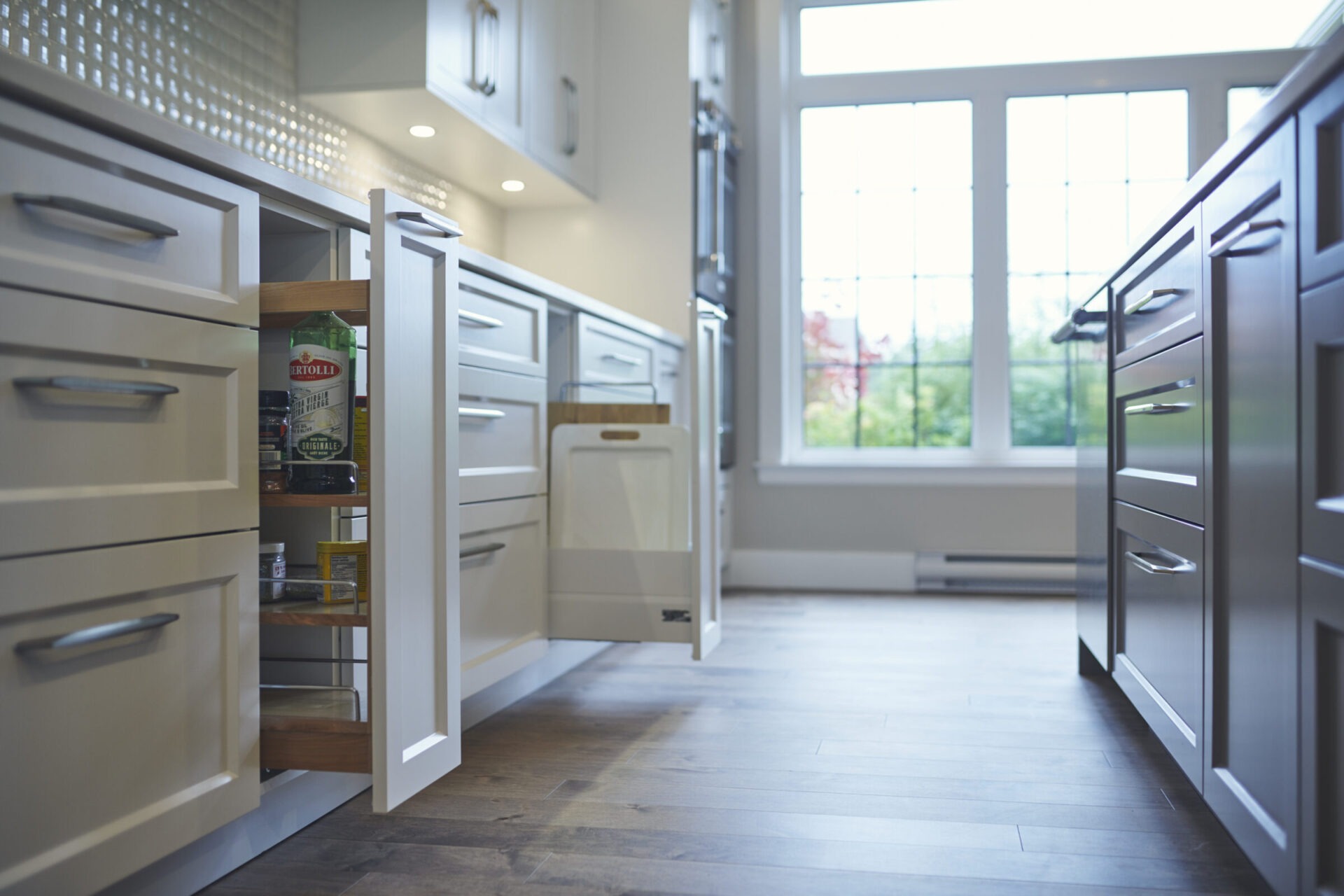
A kitchen should support the routines you rely on, not the other way around. That’s why custom cabinetry is often the most valuable part of any kitchen design. Consider how you will need to use your kitchen daily, as well as during holidays and special occasions. For instance, a home baker might need deep drawers for pots and sheet pans, or room for a stand mixer to be tucked away but still within reach. A family with busy mornings could use the extra built-in storage for a pantry filled with snacks for school lunches, soft-close drawers for easy access and extra counter space for the many things that never get put away.
Kitchen storage is one of the most important yet overlooked aspects of good design. From spice drawers and pull-out trays to corner cabinets with rotating shelves, maximizing every square inch matters. Consider how your kitchen can better support the way you live—whether that’s keeping countertops clear, organizing specialty tools, or hiding away seasonal items you only need a few times a year. A smart storage plan ensures everything has its place, which means less visual clutter and more room to breathe.
Open shelving can work beautifully when styled properly, especially for dishes or tools you use every day. Closed cabinetry keeps your kitchen looking structured and free from clutter. Tilt-out bins and other built-in options make use of valuable space forgotten about in standard kitchen designs.
When your cabinetry is well-planned and intentional, it makes your entire kitchen easier to work with and live in.
Layouts That Adapt to Daily Life

The most beautiful kitchen in the world won’t feel right if the layout doesn’t support the way you live day-to-day. A kitchen should work for you at each part of your day. Instead of relying on the traditional work triangle, consider designing in zones. Think about where you prep meals, where dishes tend to collect, and what you need to grab quickly during busy moments. Prep, cook, clean and serve; each zone should lead naturally into the next. A strong layout creates a sense of openness, even when the space is limited. It allows multiple people to use the kitchen comfortably and helps daily routines run more smoothly.
A layout that supports flow makes the space easier to live in, from weekday mornings to weekend dinners.
Get More from a Kitchen Island

A kitchen island should serve a real purpose. With thoughtful design, it becomes the centre of activity for cooking, gathering and day-to-day living. If your kitchen is a space for entertaining, consider a built-in wine fridge for added function or seating along one side to encourage conversation. If cooking takes priority, you might opt for a prep sink or butcher block surface. In busy family homes, deep drawers for dinnerware or space for kids’ projects can make the island even more useful.
Lighting adds impact. Pendant lights above the island define the space and provide focused task lighting. Choosing finishes that match your faucet or cabinet hardware helps create visual continuity throughout the room.
Whether your kitchen is open-concept or more contained, a well-designed island brings both purpose and balance.
Make the Room Yours with Personal Touches
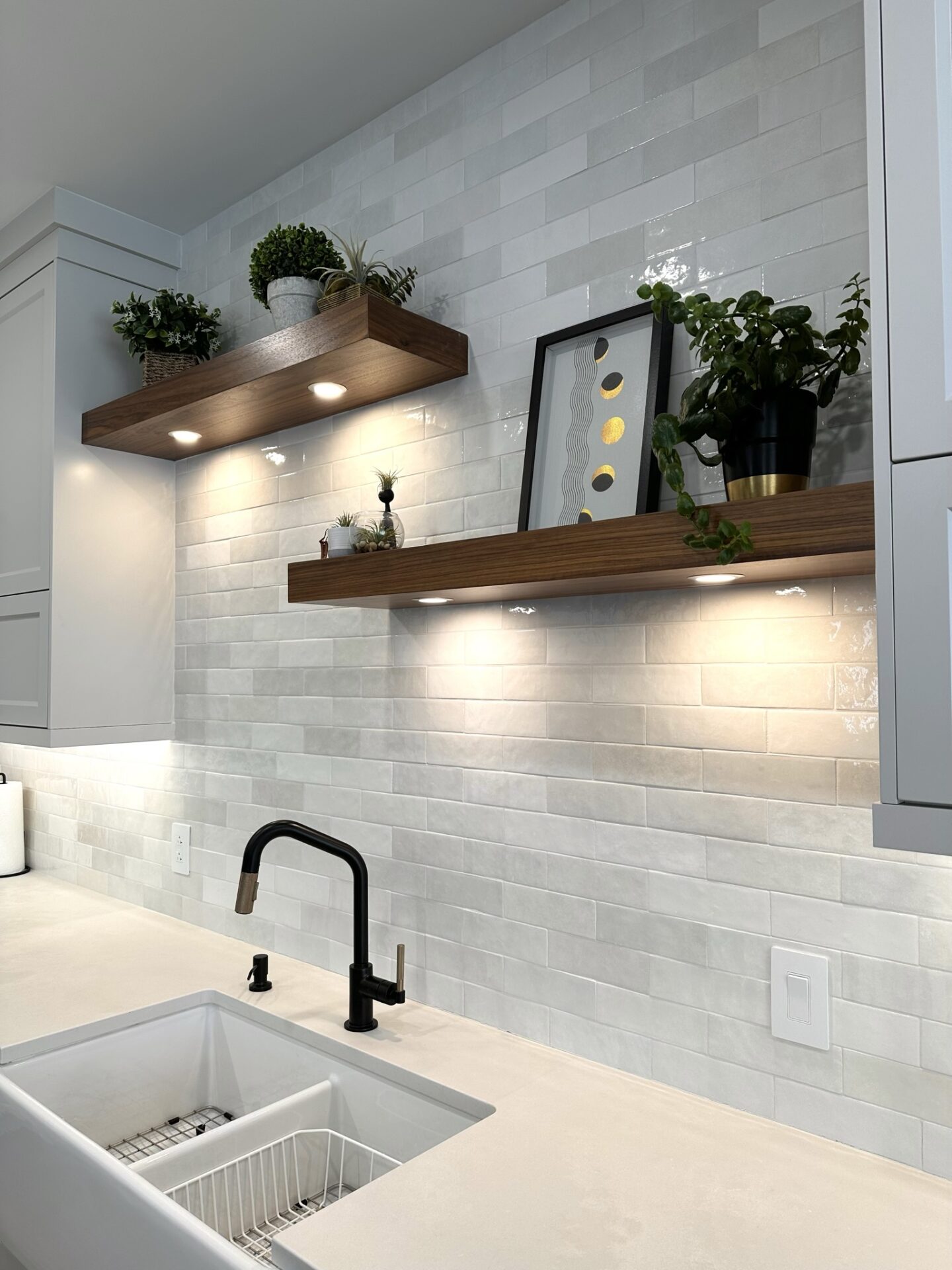
Kitchens serve a purpose, but the most meaningful ones tell a story. Small, thoughtful details turn a functional space into something personal and lasting.
Highlight items with personal significance. A hand-painted dish from a local maker, a recipe card in a loved one’s handwriting or a framed photo of your favourite place along the coast. These subtle details bring emotion into your design, so showcase them on open shelving or behind glass-front cabinets. Add warmth with natural materials like pottery, linen and woven runners to build character without creating clutter.
Personal touches like these give the kitchen its identity. They reflect what matters most to you and add meaning to the space you spend the most time in.
Use Artwork to Shape the Space

Artwork brings depth, personality and a story to your kitchen. A coastal print, a food-inspired illustration or a piece from a local artist can create a meaningful connection to place without overwhelming the space. Think about where your eye naturally lands, and include a framed piece near the breakfast nook or a small print above open shelving. Subtle details can shift the mood without the unnecessary clutter. Keep it simple and intentional. One or two well-placed pieces often speak louder than a full gallery wall, especially in a room designed for function as much as comfort.
When colour and artwork are thoughtfully chosen, they help shape a kitchen that feels grounded, expressive and unmistakably yours.
Smart Kitchen Design Ideas for Small Spaces
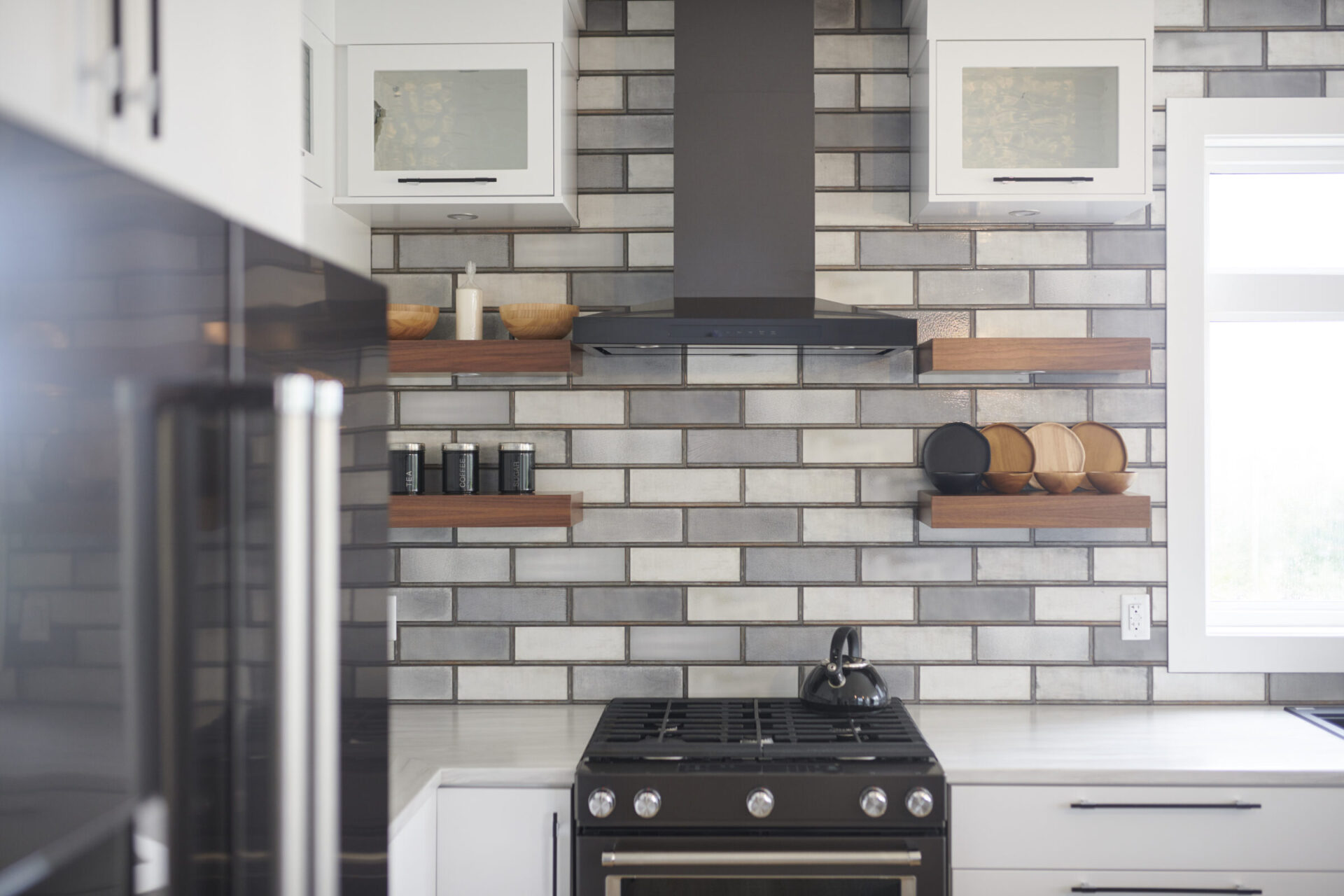
You don’t need a large kitchen to make a big impact. Small spaces can be incredibly functional and full of charm when approached thoughtfully. The key is making the most of what you have—starting with smart layout choices and clutter-free surfaces. Wall-mounted shelves, magnetic knife strips, and hanging rails can free up drawer and counter space. Opt for multi-purpose pieces like cutting boards that fit over the sink, or compact appliances that can be tucked away when not in use.
Lightweight, flexible design updates can also make a small kitchen feel refreshed without a full renovation. Use mirrors or glossy finishes to reflect light and open up the space visually. Choose lighter fabrics, soft linen towels, or a bright rug to add texture without bulk. Even a simple update—like a new vase, a bowl of seasonal fruit, or a fresh coat of paint—can shift the mood of your kitchen and make it feel more open and intentional.
With the right mix of function and style, your small kitchen can feel just as personal, hardworking, and inviting as any larger space.
Open Concept Kitchen Design That Connects
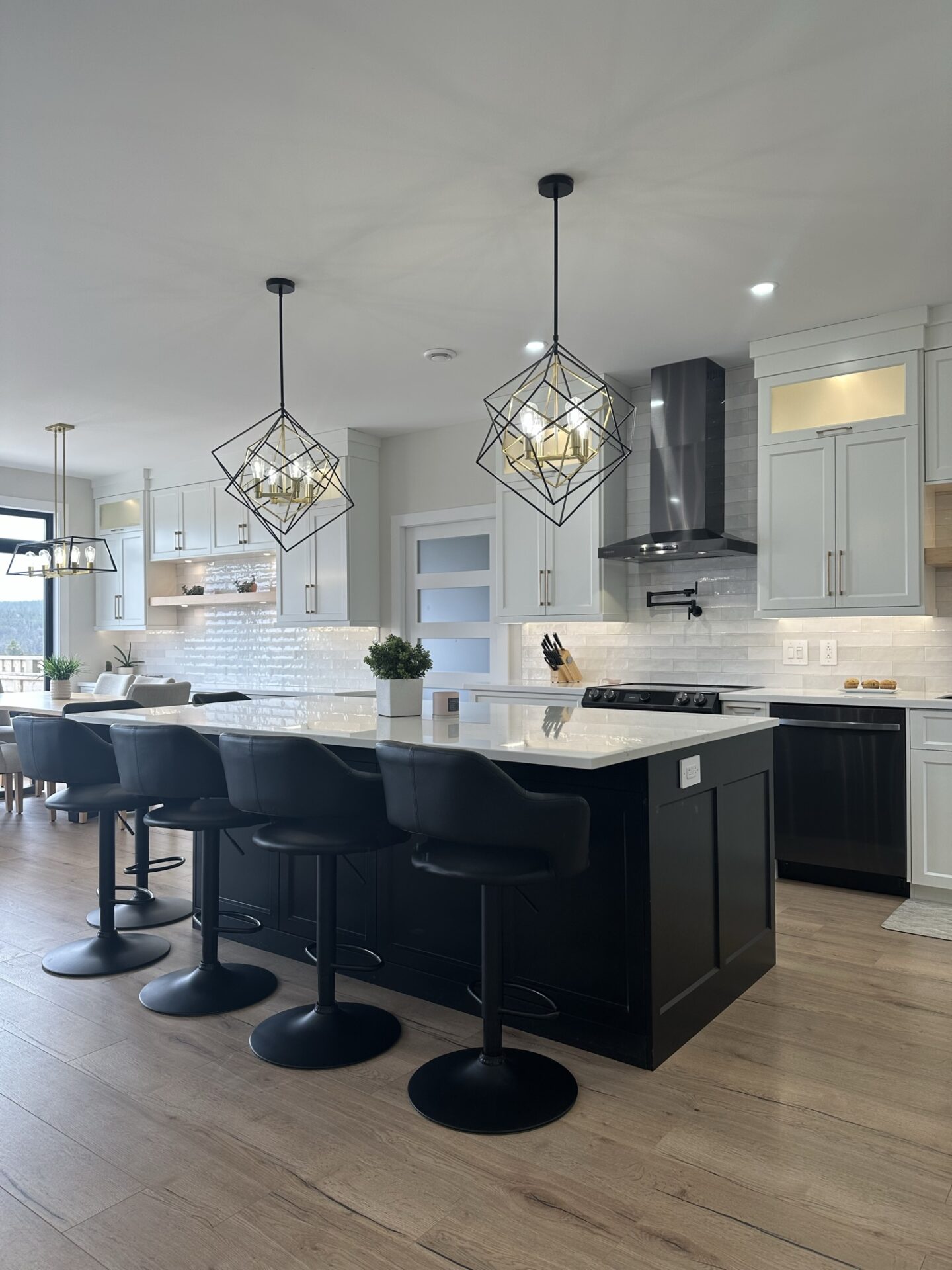
In many Newfoundland homes, open-concept layouts are a natural fit. Removing walls between the kitchen, dining, and living areas brings in more light, improves flow, and encourages connection throughout the home.
The kitchen can remain its own distinct zone even in an open layout. Use an island to define the space. Keep flooring, cabinetry colours and lighting consistent from room to room to maintain visual cohesion. Prioritize clear pathways and thoughtful placement so the layout supports both movement and conversation.
This approach fosters togetherness. You can cook while staying part of the conversation or prep meals while helping with homework. It ensures your kitchen keeps up with the pace of everyday life, and leaves everything feeling a little more connected.
Design a Kitchen That Adapts to Your Routine
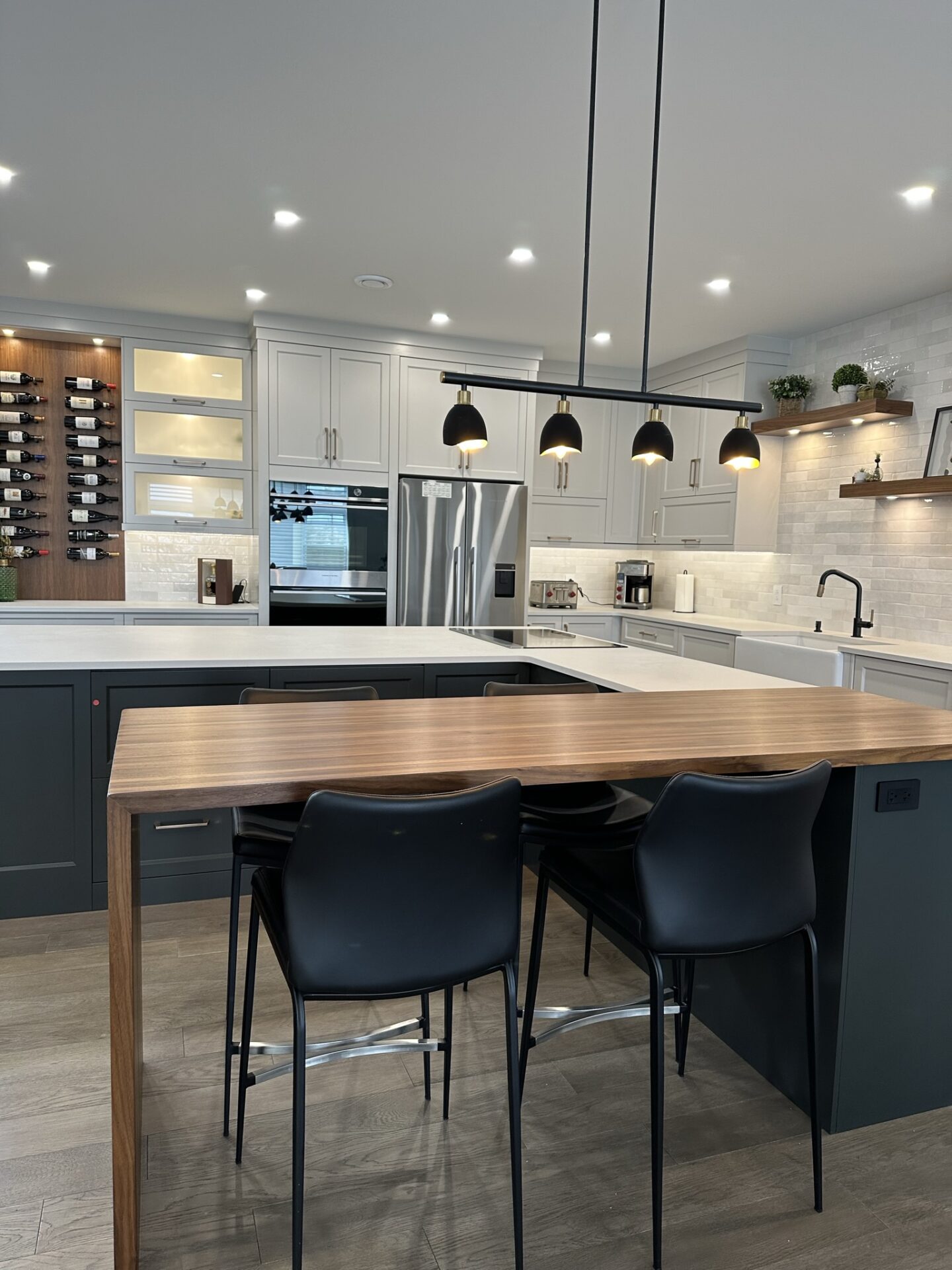
The most practical kitchens are designed to flex with your daily life. Needs change sometimes, either with the season or for a new stage in life, and your kitchen should be able to keep up. That could mean adding seating that folds away when not in use, shelving that adjusts in height as your storage needs shift or smart lighting that is programmed to change at certain times throughout the day.
Think practically about how each feature might serve more than one role. A built-in bench that doubles as a workspace, or a dining table that extends with added seating when guests visit. Features that serve more than one purpose make for an intuitive kitchen, not one that’s improvised.
In Newfoundland, where routines need to shift with weather and lifestyle, having a flexible design ensures your kitchen stays relevant and comfortable, no matter what tomorrow looks like.
Entertainer’s Kitchen Ideas for Effortless Hosting
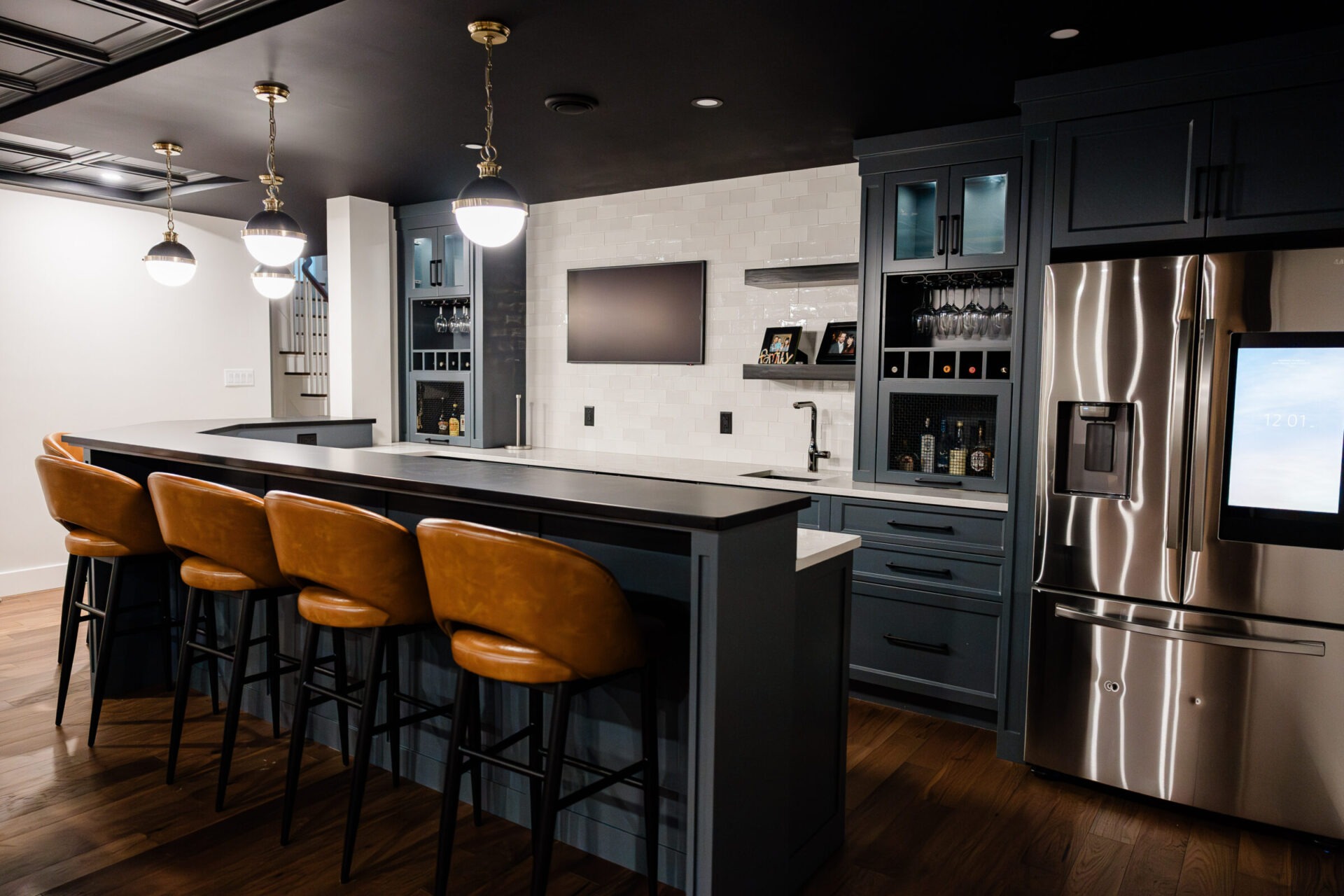
Love hosting? Your kitchen should make it effortless. These entertainer’s kitchen ideas focus on flow, function, and feeling welcome.
Start with an open layout and a central island for gathering and serving. Durable surfaces like quartz and layered lighting help the space shift from prep to party. Built-in wine storage, deep drawers for platters, and a separate beverage zone keep essentials within reach. Even small touches—like a second sink or built-in speakers—can enhance the vibe.
With the right design, your kitchen becomes more than a workspace, it is why people love to gather.
Sustainable Kitchen Choices That Make Sense

Sustainable kitchen design is about making thoughtful choices that support both your needs and those of the environment. The right choices reduce maintenance, lower your environmental impact and help your kitchen function better over time.
Start with materials that are responsibly sourced and built to endure, such as FSC-certified wood, recycled stone or glass finishes. These options look natural and age well in high-use areas. Choose energy-efficient appliances like induction cooktops or low-consumption dishwashers to reduce utility costs. LED lighting offers longevity and lower energy use, while smart thermostats give you better control over your home’s efficiency year-round.
Plan Lighting That Works All Day

Lighting influences how your kitchen adapts throughout the day and shapes everything from visibility during food preparation, to soft comfort lighting during downtime.
The most effective lighting plans use layering to meet different needs throughout the day. Overhead fixtures illuminate the full space, while under-cabinet lighting provides focused visibility for detailed tasks like chopping or measuring. Accent lighting softens the room in the evening and creates a soothing atmosphere, which is especially important during Newfoundland’s darker months.
Opt for warm-toned LED bulbs to reduce glare and create comfort. Dimmers allow lighting to shift with your needs, whether you’re making coffee at sunrise or clearing up after dinner. With the right plan, your kitchen lighting will feel natural and intuitive all day long.
Add Smart Tech Where It Helps Most

Tech-smart kitchens are meant to support your daily habits. When done correctly, the right technology can simplify your routine, save you time, and stay out of the way while doing it. Look for solutions that serve a real purpose. A refrigerator that monitors your groceries and alerts you when supplies run low, an oven you can preheat from your phone while you’re still out, or a motion-sensor faucet that makes cleanup easier when your hands are full. A built-in indoor garden, like a climate-controlled herb grower, can bring fresh ingredients right to your island while reducing food waste and trips to the store. When smart features are aligned with how you live, they help your kitchen run smoothly and quietly enhance your space without being the main focus.
Use Finishes to Bring It All Together
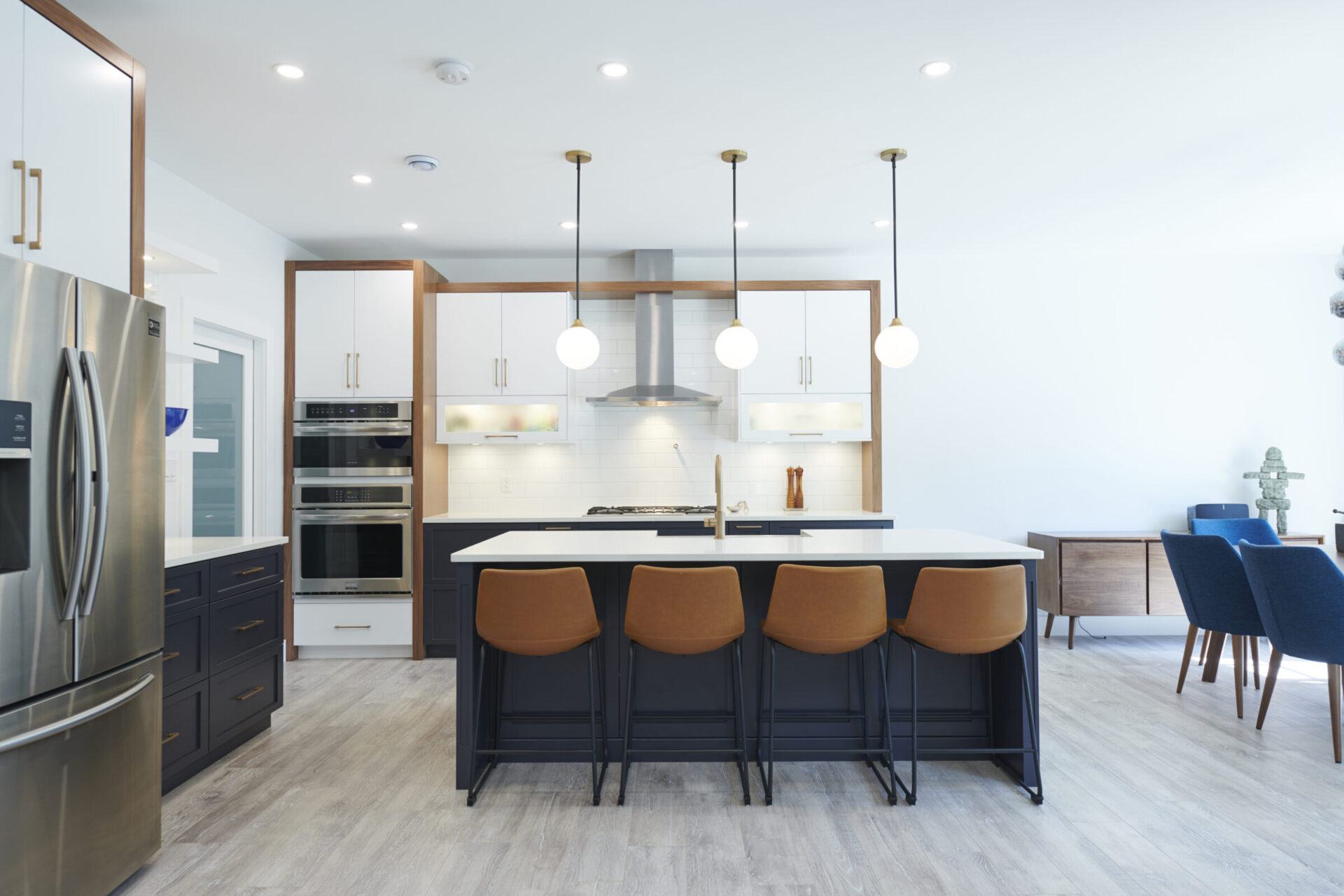
Details carry weight. Once the main elements are in place, the right finishes tie everything together and give the kitchen its final sense of purpose. Repeat materials where it feels natural, like echoing wood tones across open shelving and floors, or coordinating your lighting, hardware and plumbing fixtures. This creates quiet consistency that feels polished, not overly styled.
Even small changes, like a new cabinet pull, a soft runner or fresh trim colour, can pull the space together. These finishing touches help your kitchen feel considered, complete and entirely your own.
Create a Kitchen That Lasts Through the Seasons
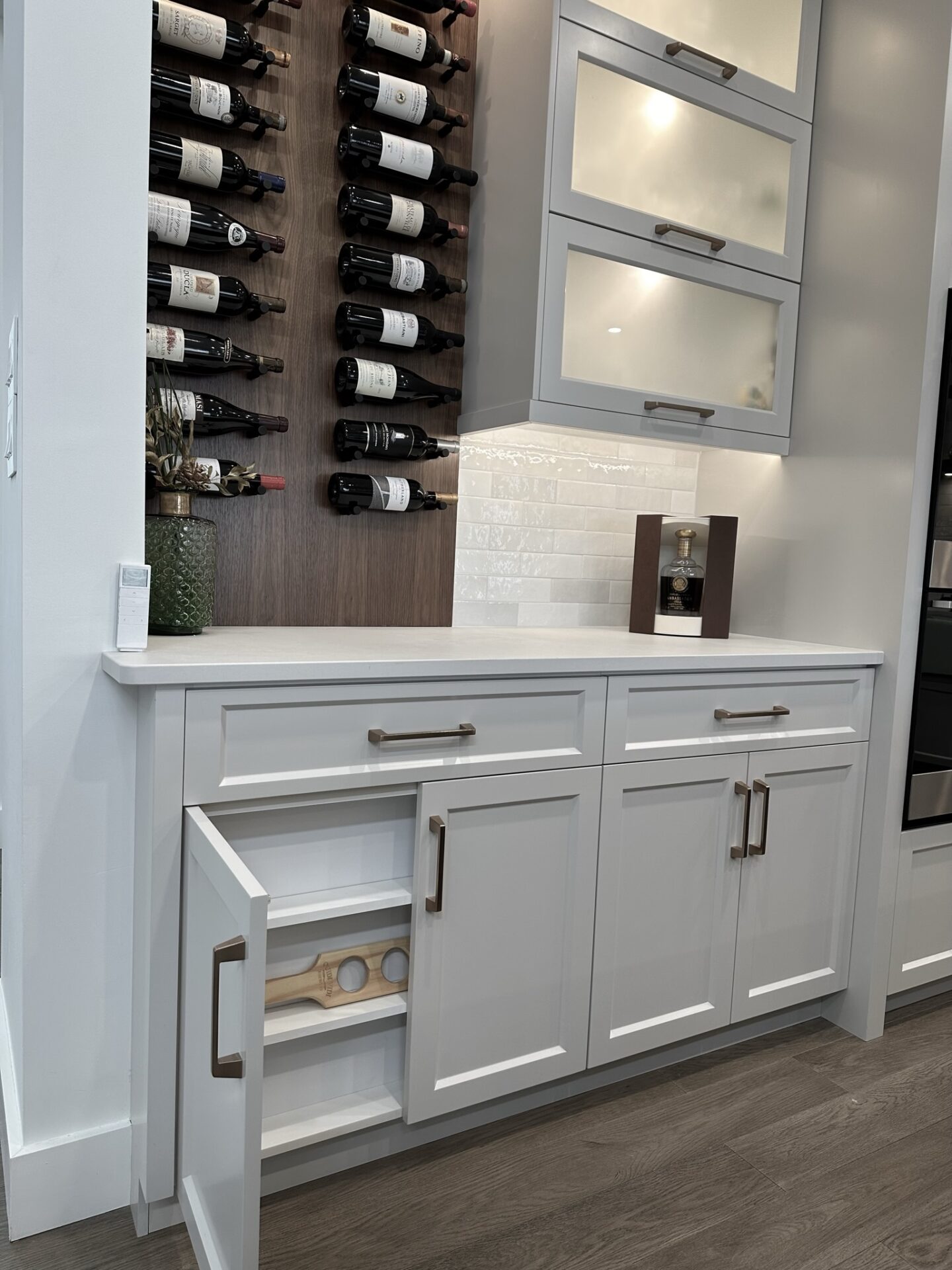
A kitchen should be able to grow with you. Designing for longevity means you’ll need to think beyond just finishes and plan for how you might need to use your kitchen in five, ten or twenty years from now. To recap:
Start with choosing a layout that supports movement and multitasking, so the room is functional when you’re making school lunches or hosting a holiday dinner. A kitchen built for entertaining should allow guests to gather comfortably without disrupting the flow of cooking or prep. Add base cabinets with adjustable shelving that can shift with changing storage needs. Install wall outlets with built-in USB ports to future-proof charging stations without cluttering the counter.
Then, select surfaces that maintain their beauty even with everyday wear. Materials like textured porcelain tile that hides scuffs, cabinet paint with a wipeable satin finish or quartz that resists heat and staining without needing sealants. Use soft-close drawers and solid hardware that will last, even in high-use areas.
Remember to include room for change. Leave one wall open for a future coffee nook or bar setup, or opt for modular pantry systems you can reconfigure. Even smaller choices, like installing task lighting on independent switches or choosing fixtures that can be easily swapped, make it easier to adapt your kitchen without starting over. The most reliable kitchens are built with flexibility, comfort and care.
Still Looking for the Right Ideas?
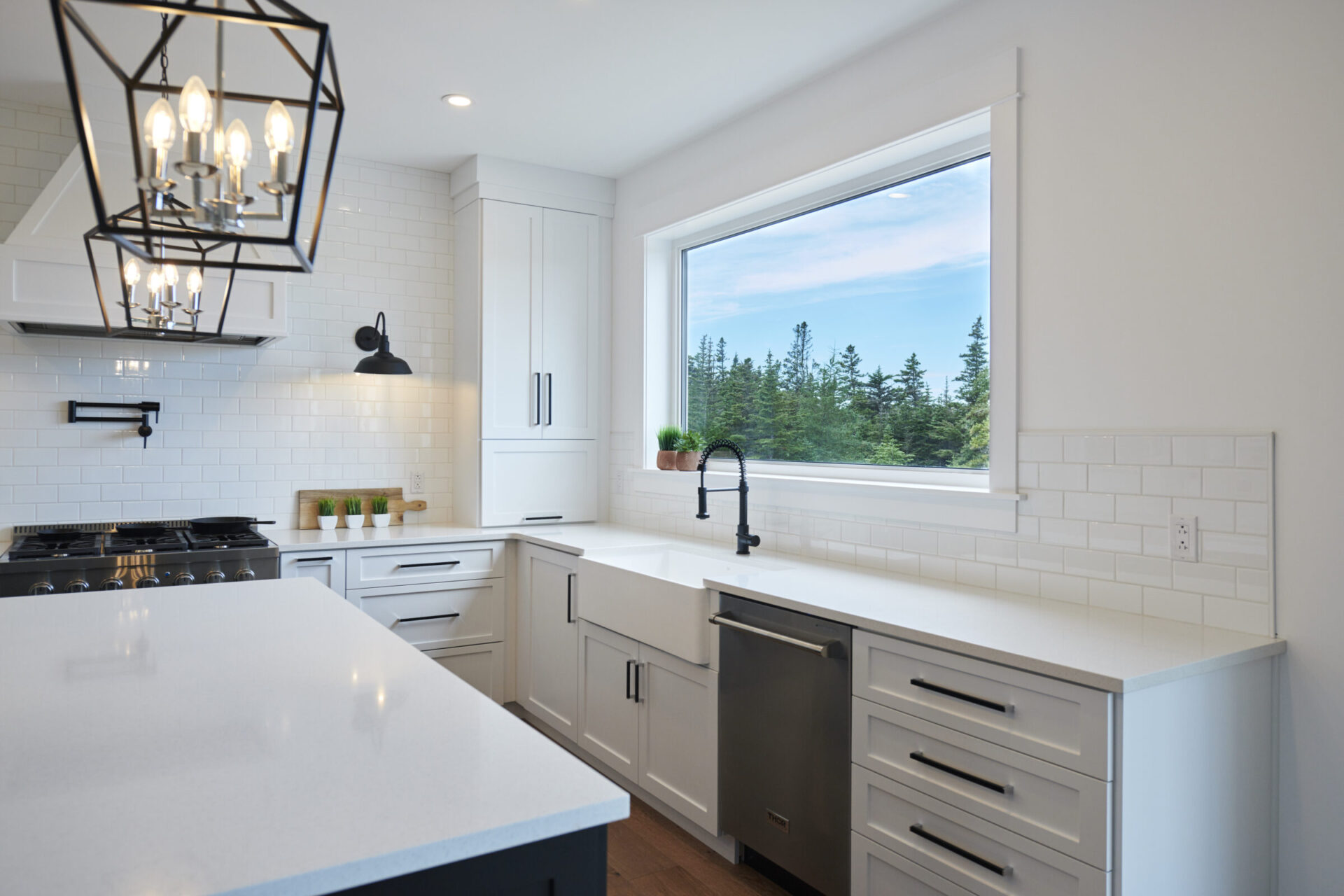
Most kitchen inspiration doesn’t reflect the way we live in Newfoundland. It misses the mark on our weather, our heritage, and the everyday rhythm of life around the kitchen table. Your space should be built for that reality—where guests drop by unannounced, stories are shared over tea, and every corner has a purpose.
This kitchen inspiration guide was created to offer practical, beautiful ideas rooted in how you truly live. From thoughtful layouts to finishes inspired by the local landscape, it’s the kitchen design Newfoundland homeowners can count on to balance comfort, function, and lasting style.
At Elite Kitchens + Design, we turn that vision into reality. If you’re ready to go beyond generic and create a kitchen that fits your life in every detail, get a quote today—we’re here to help.
